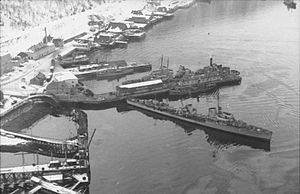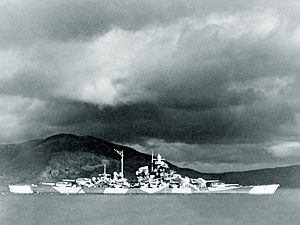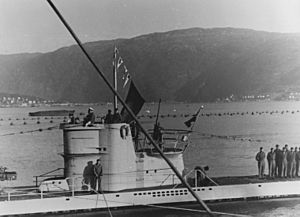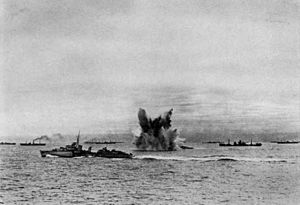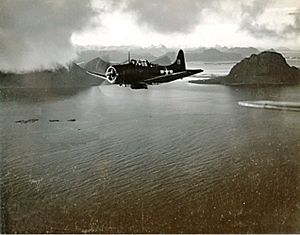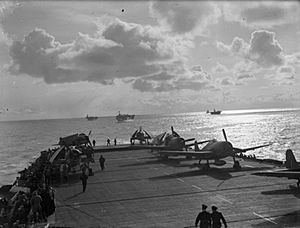Arctic naval operations of World War II facts for kids
Quick facts for kids Arctic naval operations of World War II |
|||||||
|---|---|---|---|---|---|---|---|
| Part of the European Theater and the Battle of the Atlantic of World War II | |||||||
 Map of the area of greatest naval activity. |
|||||||
|
|||||||
| Belligerents | |||||||
| Commanders and leaders | |||||||
During World War II, important naval battles and operations took place in the cold Arctic Ocean. These events were a key part of the larger Battle of the Atlantic and the European Theater of World War II. The Arctic region was vital for shipping supplies, especially to the Soviet Union, making it a dangerous battleground for ships and submarines.
Before the war, the Arctic was mainly used for fishing and transporting metal ores. Soviet towns along the Barents Sea and Kara Sea coasts relied on summer shipping for supplies. The Winter War (1939-1940) between Finland and the Soviet Union opened a new front in the north. At first, the Soviet Northern Fleet had only a few destroyers, but many submarines and minesweepers.
When Germany invaded Norway in 1940 (called Operation Weserübung), their navy, the Kriegsmarine, gained new bases. These bases allowed large German warships, known as capital ships, to challenge the British Royal Navy. German aircraft also flew from Norwegian airfields, looking for Allied ships.
After Germany invaded the Soviet Union in 1941, the Allies (Britain, the US, and Canada) started sending Arctic convoys. These were groups of freighters carrying military supplies to the Soviet Union. They were protected by warships like destroyers, corvettes, and minesweepers. Larger warships, including battleships and aircraft carriers, often sailed nearby to protect the convoys from powerful German ships.
Both the Soviet Union and Germany also used smaller coastal convoys. The Soviets needed supplies for their Arctic coast, while Germany transported metal ores from Scandinavia and supplied their troops. Both sides laid mines and cleared them in these narrow, shallow waters.
Contents
Early Years of Conflict (1939-1940)
The war in the Arctic began with ships seeking refuge and early military actions.
- In September 1939, the German ship Bremen was one of many German merchant ships that found safety in Murmansk to avoid British patrols.
- In November 1939, during the Winter War, Soviet destroyers supported an attack against Petsamo.
Invasion of Norway (1940)
Germany's invasion of Norway in April 1940 was a major event.
- German destroyers landed troops at Narvik. Large German battleships like Scharnhorst and Gneisenau fought briefly with British ships.
- The battles of Narvik involved Norwegian coastal defense ships, German U-boats (submarines), and British Royal Navy ships.
- In May 1940, the Polish destroyer Grom was sunk near Narvik by a German bomber.
- In June 1940, Allied troopships began evacuating over 24,000 soldiers from Narvik.
- German battleships Scharnhorst and Gneisenau sank the British aircraft carrier HMS Glorious and two escorting destroyers.
- In July 1940, the German raider Komet sailed through the Arctic with help from Soviet icebreakers to reach the Pacific Ocean.
- In August 1940, the American transport ship American Legion carried American citizens and important military equipment from Petsamo to New York City.
Early Allied Operations and German Attacks (1941)
As the war continued, both sides increased their activity in the Arctic.
- In March 1941, British cruisers covered a raid on Lofoten, Norway.
- In May 1941, British destroyers captured secret code documents from German weather ships near Jan Mayen.
- In June 1941, the first German U-boats were stationed in the Arctic.
- In July 1941, German destroyers attacked a small Soviet convoy, and Soviet destroyers helped stop a German advance.
- British aircraft carriers launched airstrikes on Petsamo and Kirkenes, turning back German destroyers.
- In August 1941, British submarines were sent to Murmansk.
- The first Dervish Convoy arrived in Arkhangelsk in August 1941, starting the regular transport of Allied war materials to the Soviet Union.
Convoys and Battles (1942)
The year 1942 saw many important convoys and fierce battles.
- In October 1941, the first Allied convoy, Convoy PQ 1, arrived in Arkhangelsk.
- German U-boats began sinking more Allied and Soviet ships.
- In January 1942, the German battleship Tirpitz arrived in Norway. Its presence forced the British Home Fleet to keep a strong force in the Arctic, preventing those ships from being used elsewhere.
- In March 1942, Tirpitz sailed to attack Convoy PQ 12, but British aircraft attacked it, forcing it to hide.
- In March 1942, a German U-boat was sunk by a British minesweeper.
- In late March 1942, German destroyers attacked Convoy PQ 13, sinking some ships. The British cruiser Trinidad sank a German destroyer but was damaged herself.
- In April 1942, Convoy QP 11 was attacked by German U-boats and destroyers. The British cruiser Edinburgh was torpedoed and later sank.
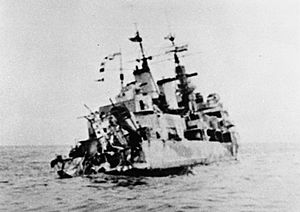
- In May 1942, during Convoy PQ 15, a British warship accidentally sank a Polish submarine.
- In June 1942, the 11th U-boat Flotilla was set up in Norway for Arctic patrols.
- In June 1942, the Northern Sea Route through the Bering Strait began carrying Lend-Lease goods from North America to the Soviet Arctic, helping to supply the Soviets.
- In July 1942, Convoy PQ 17 was ordered to scatter to avoid a major German surface attack. This made the ships easy targets, and 22 merchant ships were sunk by German aircraft and U-boats.
- In August 1942, the German battleship Scheer patrolled the Kara Sea.
- In September 1942, Convoy PQ 18 faced heavy attacks from German U-boats and bombers. Many ships were sunk, but the convoy fought back, sinking several U-boats.
- In October 1942, Operation FB tried sending merchant ships independently, but many were sunk by German U-boats and aircraft.
Turning the Tide (1943)
The Allies continued to fight hard in the Arctic, with important naval battles taking place.
- In December 1942, German warships, including Admiral Hipper and Lützow, attacked convoy JW 51B in the battle of the Barents Sea. The Germans sank some British ships, but the British covering force arrived and damaged Hipper, sinking another German destroyer.
- In January 1943, Soviet submarines sank several German ships.
- In March 1943, the presence of Tirpitz, Scharnhorst, and Lützow in Norway caused the Allies to cancel convoys for the summer.
- In July 1943, large Allied fleets, including US battleships, conducted exercises off Norway to distract from the invasion of Sicily (Operation Husky).
- From July to September 1943, German U-boats operated in the Kara Sea, sinking several Soviet ships and minesweepers. However, one German U-boat was sunk by a Soviet submarine.
- In September 1943, Scharnhorst and Tirpitz attacked Spitsbergen.
- Later in September 1943, Tirpitz was badly damaged by British mini-submarines in Operation Source.
- In October 1943, the US aircraft carrier Ranger launched an airstrike on Bodø, Norway.
- In December 1943, the German battleship Scharnhorst was sunk during the battle of the North Cape while trying to attack Allied convoys. This was a major victory for the Allies.
Final Operations (1944-1945)
The last years of the war saw continued fighting and the eventual defeat of German forces in the Arctic.
- In January 1944, German U-boats damaged and sank several ships from convoy JW 56A. One German U-boat was sunk by the convoy escort.
- In February 1944, British carrier aircraft attacked the Norwegian coast. Convoy escorts sank more German U-boats.
- In April 1944, British carrier aircraft severely damaged Tirpitz during Operation Tungsten.
- In April 1944, German U-boats sank an Allied ship, but Allied escorts sank several U-boats in return.
- In July and August 1944, British carrier aircraft repeatedly attacked Tirpitz, but it remained afloat.
- In August 1944, a German U-boat sank a British escort ship but was then sunk by British aircraft.
- German U-boat operations in the Kara Sea continued, sinking some Soviet minesweepers and a merchant ship, but also losing a U-boat.
- In September 1944, a US Coast Guard cutter captured a German weather ship off Greenland.
- In October 1944, Soviet torpedo cutters sank German minesweepers.
- In October 1944, Soviet naval infantry, supported by Soviet warships, captured Kirkenes.
- In November 1944, Operation Catechism saw British Royal Air Force bombers finally sink the battleship Tirpitz. This removed the biggest threat to Allied convoys in the Arctic.
- In December 1944, the 14th U-boat Flotilla was established in Narvik as German U-boat bases in France were captured.
- In January 1945, a German U-boat sank the Soviet destroyer Dejatelnyj.
- In February 1945, German U-boats continued to attack convoys, sinking some ships. One American Liberty ship, the Henry Bacon, was the last ship sunk by German aircraft in World War II.
- In April 1945, in one of the last convoy battles of the war, a German U-boat sank a British ship, but the convoy escorts sank two U-boats.
- Even after Germany surrendered in May 1945, supply ships from the United States continued to travel through the Bering Strait to the Soviet Union. This was to encourage the Soviet Union to declare war on Japan.
Images for kids
-
Burning fish oil tanks on Lofoten viewed from HMS Legion during Operation Claymore.


